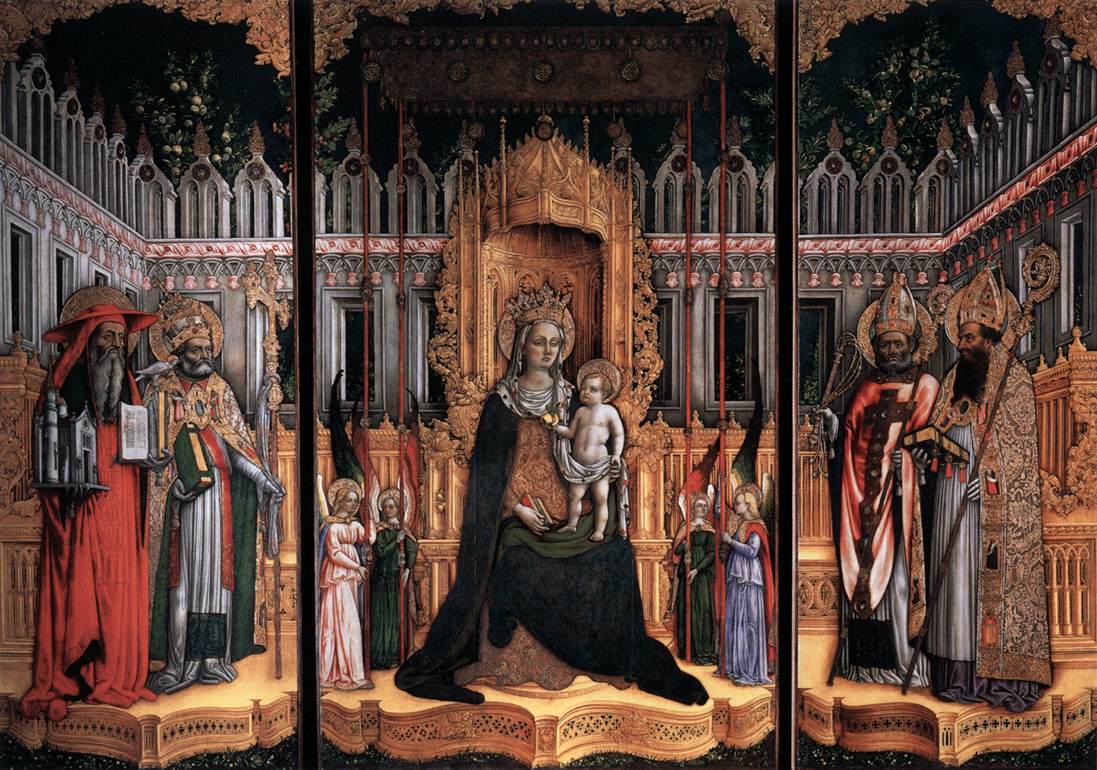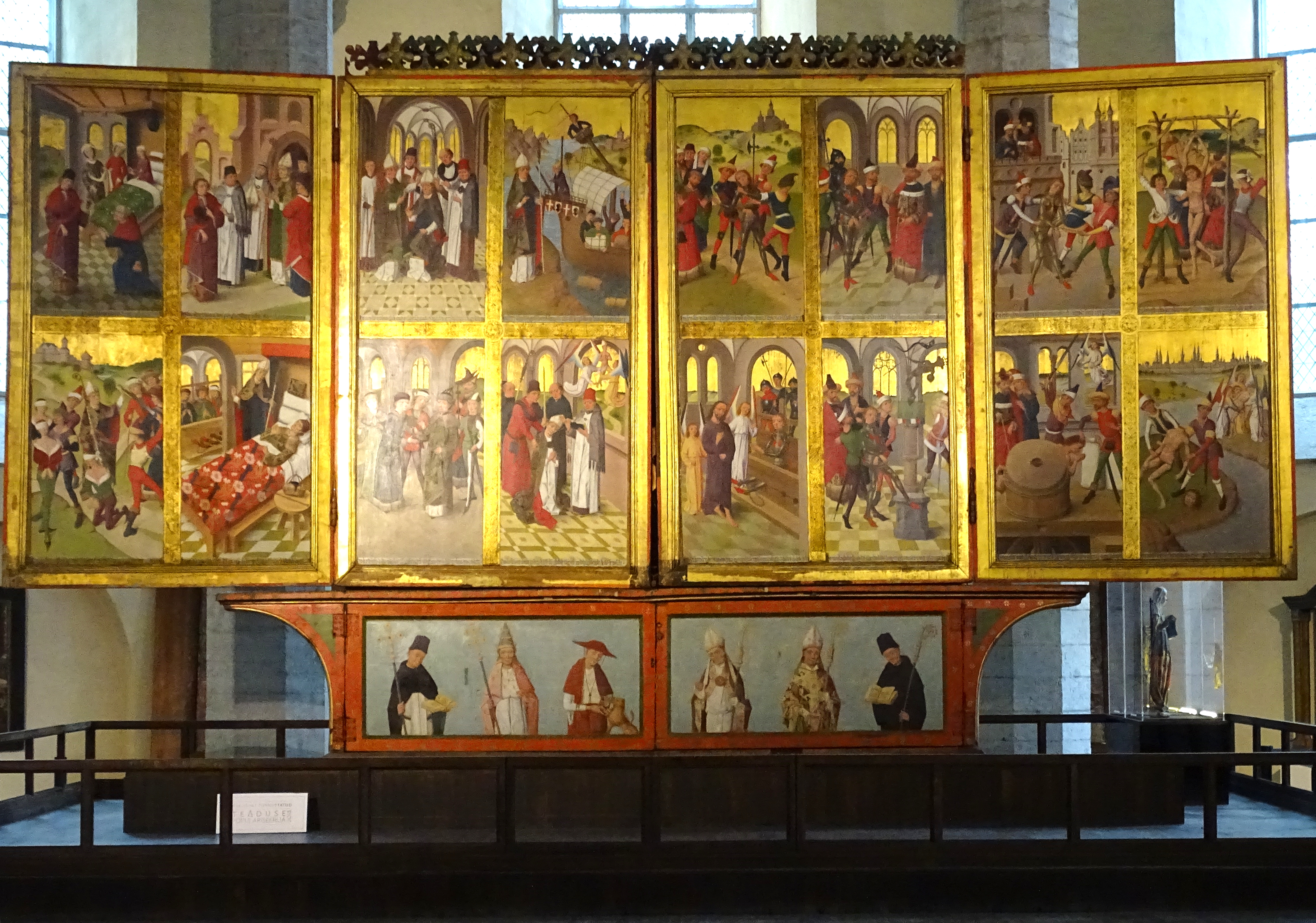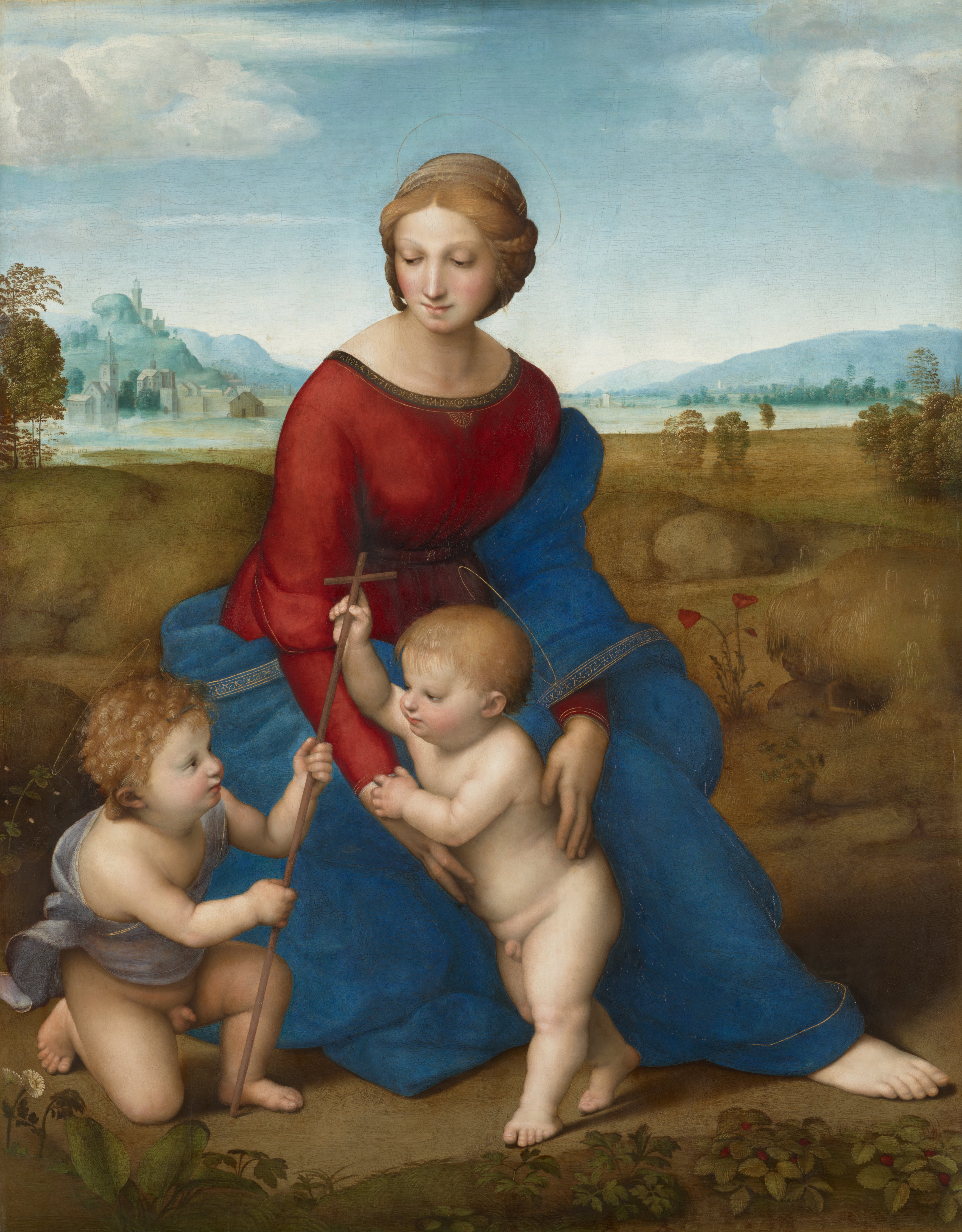|
Giovanni D'Alemagna
Giovanni d'Alemagna (; born Johannes Alamanus; 9 July 1450) was a Venetian renaissance painter of German ancestry, active in Italy, with his brother-in-law Antonio Vivarini on religious paintings in Venice and Padua, that are preserved in the named cities together with those of Vivarini. Biography Giovanni d'Alemagna is remembered above all for the work done in Venice, characterized by decorative forms that recall Nordic influence. Between 1430 and 1435 he created a cycle called Stories of Christ, which are still exhibited at the Ca' d'Oro. According to Ridolfo and Zanetti, Giovanni and Antonio Vivarini flourished about the year 1440, where they adduce authority for an altar-piece in San Pantalon, which bears the inscription of Zuane e Antonio da Muran pense 1444. Although it is difficult to distinguish the two artists' contributions, Giovanni is associated with the St Jerome (1444), which carries the signature 'Johannes'. This painting suggests that Giovanni's work was gener ... [...More Info...] [...Related Items...] OR: [Wikipedia] [Google] [Baidu] |
Venice
Venice ( ; it, Venezia ; vec, Venesia or ) is a city in northeastern Italy and the capital of the Veneto Regions of Italy, region. It is built on a group of 118 small islands that are separated by canals and linked by over 400 bridges. The islands are in the shallow Venetian Lagoon, an enclosed bay lying between the mouths of the Po River, Po and the Piave River, Piave rivers (more exactly between the Brenta (river), Brenta and the Sile (river), Sile). In 2020, around 258,685 people resided in greater Venice or the ''Comune di Venezia'', of whom around 55,000 live in the historical island city of Venice (''centro storico'') and the rest on the mainland (''terraferma''). Together with the cities of Padua, Italy, Padua and Treviso, Italy, Treviso, Venice is included in the Padua-Treviso-Venice Metropolitan Area (PATREVE), which is considered a statistical metropolitan area, with a total population of 2.6 million. The name is derived from the ancient Adri ... [...More Info...] [...Related Items...] OR: [Wikipedia] [Google] [Baidu] |
Quirizio Di Giovanni Da Murano
Quirizio di Giovanni da Murano or Quirizio da Murano or Quiricius (Venice ), was an Italian people, Italian Renaissance painter of religious subjects. Biography Little is known about this painter. He is supposed to have been a pupil of Antonio of Murano, though conjectures by critics vary about him and his work. The probability is that he did little alone, but was one of the assistants in the Vivarini workshop. His use of tempera is similar to the school of Murano, flat, light, and with little or no shade. His type of head is regular and well-shaped, fingers and neck long, waist very slender. Works * ''The Savior'' / ''Christ Showing His Wounds and the Host to a Clarissan Nun'' (1460–1478) : The painting was made for the monastery of Poor Clares, Saint Clare on Murano island and shows a rather feminine Christ holding his wounded breast. Now in thAcademia in Venice painting tempera and oil on panel. * (Venice, ) (tempera) [...More Info...] [...Related Items...] OR: [Wikipedia] [Google] [Baidu] |
15th-century Italian Painters
The 15th century was the century which spans the Julian dates from 1 January 1401 ( MCDI) to 31 December 1500 ( MD). In Europe, the 15th century includes parts of the Late Middle Ages, the Early Renaissance, and the early modern period. Many technological, social and cultural developments of the 15th century can in retrospect be seen as heralding the "European miracle" of the following centuries. The architectural perspective, and the modern fields which are known today as banking and accounting were founded in Italy. The Hundred Years' War ended with a decisive French victory over the English in the Battle of Castillon. Financial troubles in England following the conflict resulted in the Wars of the Roses, a series of dynastic wars for the throne of England. The conflicts ended with the defeat of Richard III by Henry VII at the Battle of Bosworth Field, establishing the Tudor dynasty in the later part of the century. Constantinople, known as the capital of the world ... [...More Info...] [...Related Items...] OR: [Wikipedia] [Google] [Baidu] |
German Male Painters
German(s) may refer to: * Germany (of or related to) **Germania (historical use) * Germans, citizens of Germany, people of German ancestry, or native speakers of the German language ** For citizens of Germany, see also German nationality law **Germanic peoples (Roman times) * German language **any of the Germanic languages * German cuisine, traditional foods of Germany People * German (given name) * German (surname) * Germán, a Spanish name Places * German (parish), Isle of Man * German, Albania, or Gërmej * German, Bulgaria * German, Iran * German, North Macedonia * German, New York, U.S. * Agios Germanos, Greece Other uses * German (mythology), a South Slavic mythological being * Germans (band), a Canadian rock band * "German" (song), a 2019 song by No Money Enterprise * ''The German'', a 2008 short film * "The Germans", an episode of ''Fawlty Towers'' * ''The German'', a nickname for Congolese rebel André Kisase Ngandu See also * Germanic (other) * Germa ... [...More Info...] [...Related Items...] OR: [Wikipedia] [Google] [Baidu] |
15th-century German Painters
The 15th century was the century which spans the Julian calendar, Julian dates from 1 January 1401 (Roman numerals, MCDI) to 31 December 1500 (Roman numerals, MD). In History of Europe, Europe, the 15th century includes parts of the Late Middle Ages, the Early Renaissance, and the early modern period. Many technological, social and cultural developments of the 15th century can in retrospect be seen as heralding the "European miracle" of the following centuries. The Perspective (graphical), architectural perspective, and the modern fields which are known today as banking and accounting were founded in Italy. The Hundred Years' War ended with a decisive Kingdom of France, French victory over the Kingdom of England, English in the Battle of Castillon. Financial troubles in England following the conflict resulted in the Wars of the Roses, a series of dynastic wars for the throne of England. The conflicts ended with the defeat of Richard III by Henry VII of England, Henry VII at th ... [...More Info...] [...Related Items...] OR: [Wikipedia] [Google] [Baidu] |
1450 Deaths
*
{{Number disambiguation ...
145 may refer to: *145 (number), a natural number *AD 145, a year in the 2nd century AD * 145 BC, a year in the 2nd century BC *145 (dinghy), a two-person intermediate sailing dinghy * 145 (South) Brigade * 145 (New Jersey bus) See also * List of highways numbered 145 The following highways are numbered 145: Australia * Lower Barrington Road, Paloona Road, Melrose Road, Bellamy Road, Forthside Road (Tasmania) * Inverleigh–Winchelsea Road (Victoria) Canada * Winnipeg Route 145 * New Brunswick Route 145 * ... [...More Info...] [...Related Items...] OR: [Wikipedia] [Google] [Baidu] |
1411 Births
Year 1411 ( MCDXI) was a common year starting on Thursday (link will display the full calendar) of the Julian calendar. Events January–December * February 1 – The First Peace of Thorn is signed at Thorn in the Monastic State of the Teutonic Knights, ending the Polish–Lithuanian–Teutonic War. * February 17 – Ottoman Interregnum: Süleyman Çelebi is killed after being forced to flee his capital, Edirne, by his brother Musa Çelebi. Rule of the Ottoman domains in Europe ( Rumelia) passes to Musa. * July 6 – Ming dynasty Admiral Zheng He returns to Nanjing after his second voyage, and presents the Sinhalese king, captured during the Ming–Kotte War, to the Yongle Emperor. * July 24 – Battle of Harlaw in Scotland: Domhnall of Islay, Lord of the Isles, and an army commanded by Alexander Stewart, Earl of Mar battle to a bloody draw. * September 3 – The Treaty of Selymbria is concluded between the Ottoman Empire and the Republic of Ven ... [...More Info...] [...Related Items...] OR: [Wikipedia] [Google] [Baidu] |
Church Of San Zaccaria
The Church of San Zaccaria is a 15th-century former monastic church in central Venice, Italy. It is a large edifice, located in the Campo San Zaccaria, just off the waterfront to the southeast of Piazza San Marco and St Mark's Basilica. It is dedicated to St. Zechariah, the father of John the Baptist. History The first church on the site was founded by Doge Giustiniano Participazio in the early 9th century to house the body of the saint to which it is dedicated, a gift of the Byzantine Emperor Leo V the Armenian, which it contains under the second altar on the right. The remains of various doges are buried in the crypt of the church. The original church was rebuilt in the 1170s (when the present campanile was built) and was replaced by a Gothic church in the 15th century. The remains of this building still stand, as the present church was built beside and not over it. The present church was built between 1458 and 1515. Antonio Gambello was the original architect, who started t ... [...More Info...] [...Related Items...] OR: [Wikipedia] [Google] [Baidu] |
Polyptych
A polyptych ( ; Greek: ''poly-'' "many" and ''ptychē'' "fold") is a painting (usually panel painting) which is divided into sections, or panels. Specifically, a "diptych" is a two-part work of art; a "triptych" is a three-part work; a tetraptych or quadriptych has four parts, and so on. Historically, polyptychs typically displayed one "central" or "main" panel that was usually the largest of the attachments; the other panels are called "side" panels, or "wings". Sometimes, as evident in the Ghent and Isenheim works (see below), the hinged panels can be varied in arrangement to show different "views" or "openings" in the piece. The upper panels often depict static scenes, while the lower register, the predella, often depict small narrative scenes. Polyptychs were most commonly created by early Renaissance painters, the majority of whom designed their works to be altarpieces in churches and cathedrals. The polyptych form of art was also quite popular among ukiyo-e printmakers ... [...More Info...] [...Related Items...] OR: [Wikipedia] [Google] [Baidu] |
Church Of The Eremitani
The Church of the Eremitani (Italian: ''Chiesa degli Eremitani''), or Church of the Hermits, is a former-Augustinian, 13th-century Gothic-style church in Padua, region of the Veneto, Italy. It is also now notable for being adjacent to the Cappella Scrovegni with Giotto frescoes and the municipal archeology and art gallery: the '' Musei Civici agli Eremitani'', which is housed in the former Augustinian monastery located to the left of the entrance. History The Augustinian hermit friars, precursors of the present Order of Saint Augustine had arrived in Padua in 1237. Through the patronage of both the wife of the local nobleman Zaccaria dell'Arena and the city, the church was erected between 1260 and 1276 and dedicated to the saints Philip and James. The friars would remain in the administration of the monastery and church until 1806, when the Napoleonic rule suppressed the order and closed the monastery. The church was re-opened to services in 1808, and in 1817 reformulated into a pa ... [...More Info...] [...Related Items...] OR: [Wikipedia] [Google] [Baidu] |
Vienna
en, Viennese , iso_code = AT-9 , registration_plate = W , postal_code_type = Postal code , postal_code = , timezone = CET , utc_offset = +1 , timezone_DST = CEST , utc_offset_DST = +2 , blank_name = Vehicle registration , blank_info = W , blank1_name = GDP , blank1_info = € 96.5 billion (2020) , blank2_name = GDP per capita , blank2_info = € 50,400 (2020) , blank_name_sec1 = HDI (2019) , blank_info_sec1 = 0.947 · 1st of 9 , blank3_name = Seats in the Federal Council , blank3_info = , blank_name_sec2 = GeoTLD , blank_info_sec2 = .wien , website = , footnotes = , image_blank_emblem = Wien logo.svg , blank_emblem_size = Vienna ( ; german: Wien ; ba ... [...More Info...] [...Related Items...] OR: [Wikipedia] [Google] [Baidu] |
Kunsthistorisches Museum
The Kunsthistorisches Museum ( "Museum of Art History", often referred to as the "Museum of Fine Arts") is an art museum in Vienna, Austria. Housed in its festive palatial building on the Vienna Ring Road, it is crowned with an octagonal dome. The term ''Kunsthistorisches Museum'' applies to both the institution and the main building. It is the largest art museum in the country and one of the most important museums worldwide. Emperor Franz Joseph I of Austria-Hungary opened the facility around 1891 at the same time as the Natural History Museum, Vienna which has a similar design and is directly across Maria-Theresien-Platz. The two buildings were constructed between 1871 and 1891 according to plans by Gottfried Semper and Baron Karl von Hasenauer. The emperor commissioned the two Ringstraße museums to create a suitable home for the Habsburgs' formidable art collection and to make it accessible to the general public. The buildings are rectangular in shape, with symmetrical ... [...More Info...] [...Related Items...] OR: [Wikipedia] [Google] [Baidu] |

.jpg)





